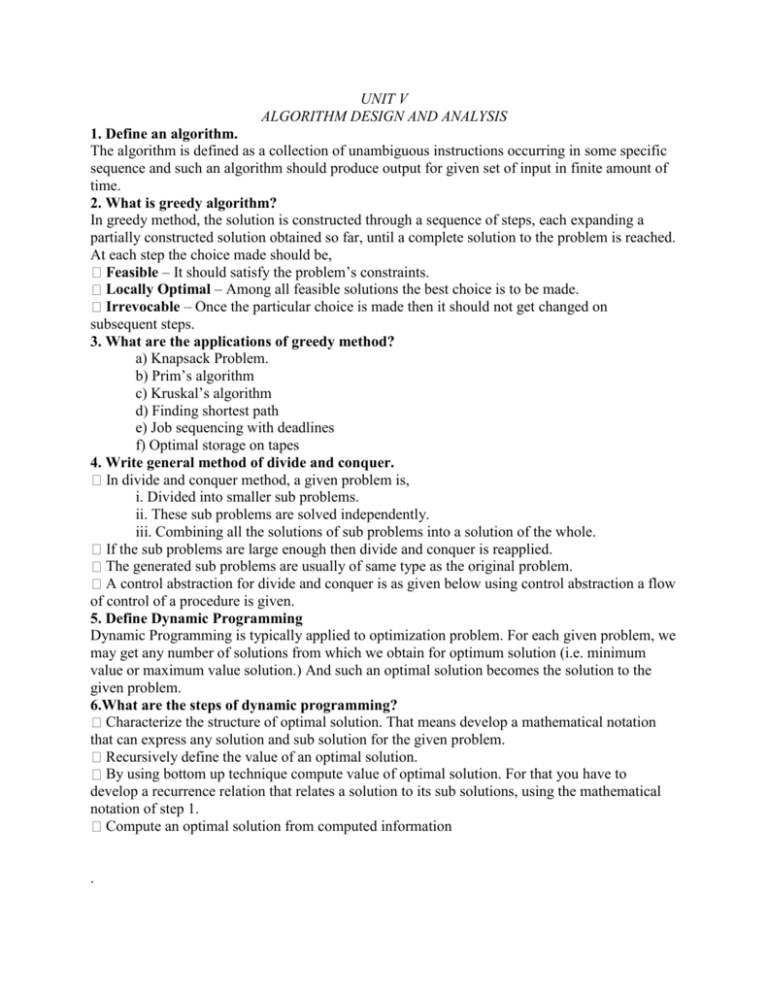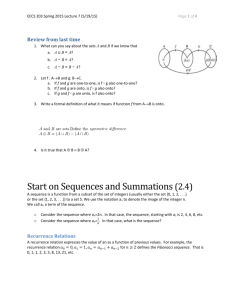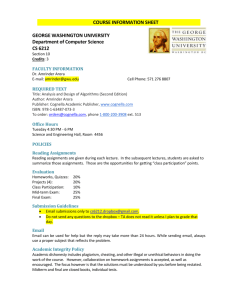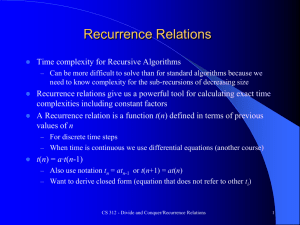File
advertisement

UNIT V ALGORITHM DESIGN AND ANALYSIS 1. Define an algorithm. The algorithm is defined as a collection of unambiguous instructions occurring in some specific sequence and such an algorithm should produce output for given set of input in finite amount of time. 2. What is greedy algorithm? In greedy method, the solution is constructed through a sequence of steps, each expanding a partially constructed solution obtained so far, until a complete solution to the problem is reached. At each step the choice made should be, Feasible – It should satisfy the problem’s constraints. Locally Optimal – Among all feasible solutions the best choice is to be made. Irrevocable – Once the particular choice is made then it should not get changed on subsequent steps. 3. What are the applications of greedy method? a) Knapsack Problem. b) Prim’s algorithm c) Kruskal’s algorithm d) Finding shortest path e) Job sequencing with deadlines f) Optimal storage on tapes 4. Write general method of divide and conquer. In divide and conquer method, a given problem is, i. Divided into smaller sub problems. ii. These sub problems are solved independently. iii. Combining all the solutions of sub problems into a solution of the whole. If the sub problems are large enough then divide and conquer is reapplied. The generated sub problems are usually of same type as the original problem. A control abstraction for divide and conquer is as given below using control abstraction a flow of control of a procedure is given. 5. Define Dynamic Programming Dynamic Programming is typically applied to optimization problem. For each given problem, we may get any number of solutions from which we obtain for optimum solution (i.e. minimum value or maximum value solution.) And such an optimal solution becomes the solution to the given problem. 6.What are the steps of dynamic programming? Characterize the structure of optimal solution. That means develop a mathematical notation that can express any solution and sub solution for the given problem. Recursively define the value of an optimal solution. By using bottom up technique compute value of optimal solution. For that you have to develop a recurrence relation that relates a solution to its sub solutions, using the mathematical notation of step 1. Compute an optimal solution from computed information . 7. Comparison between divide and conquer and dynamic programming. 8. Comparison between greedy algorithm and dynamic programming. 9. State the principle of backtracking. Backtracking is a method in which the desired solution is expressed as n tuple (x1,x2, x3….. xn)which is chosen from solution space, using backtrack formulation. The solution obtained i.e. (x1, x2, x3….. xn) can either minimizes or maximizes or satisfies the criteria function. 10. What is state space tree? A state space tree is a rooted tree whose nodes represent partially constructed solutions to given problem. In backtracking method the state space tree is built for finding the solution. This tree is built using depth first search fashion. 11. How to write an algorithm? Algorithm is basically a sequence of instructions written in simple English language. The algorithm is broadly divided into two sections. 12. What are the steps of algorithm design? 1. Understand the problem. 2. Decision making Algorithm heading It consists of name of algorithm, problem description, input and output. Algorithm body It consists of logical body of the algorithm by making use of various programming constructs and assignment statement. a. Capabilities of computational devices b. Select exact/approximate method c. Data structures d. Algorithmic strategies 3. Design of algorithm 4. Algorithm verification 5. Analysis of an algorithm 6. Coding of algorithm 13. What are the types of asymptotic notation? a. Big oh notation. b. Omega notation c. Theta notation 14. Define Big oh notation? Let F(n) and g(n) be two non negative functions. Let n0 and constant c are two integers such that n0 denotes some value of input and n> n0 similarly c is some constant such that c>0. We can write F(n)<=c*g(n). then F(n) is big oh of g(n). It is also denoted as F(n)€O(g(n)). In other words F(n) is less than g(n) is multiple of some constant c. 15. Define Recurrence equation. The recurrence equation is an equation that defines a sequence recursively. It is normally in following form T(n) = T(n-1)+n …..1 for n>0 T(0) = 0 …..2 Here equation 1 is called recurrence relation and equation 2 is called initial condition. The recurrence equation can have infinite number of sequence. The general solution to the recursive function specifies some formula. 16. Define solving recurrence equation. The recurrence relation can be solved by following methods a. Substitution method b. Master’s method 17. What is the general plan for mathematical analysis of non recursive algorithm? 1. Decide the input size based on parameter n. 2. Identify algorithm’s basic operation(s). 3. Check how many times the basic operation is executed. Then find whether the Execution of basic operation depends upon the input size n. Determine worst, average, and best cases for input of size n. If the basic operation depends upon worst case, average case, and best case then that has to be analyzed separately. 4. Set up a sum for the number of times the basic operation is executed. 5. Simplify the sum using standard formula and rules. 18. What is the general plan for mathematical analysis of non recursive algorithm? 1. Decide the input size based on parameter n. 2. Identify algorithm’s basic operation(s). 3. Check how many times the basic operation is executed. Then find whether the Execution of basic operation depends upon the input size n. Determine worst, average, and best cases for input of size n. If the basic operation depends upon worst case, average case, and best case then that has to be analyzed separately. 4. Set up the recurrence relation with some initial condition and expressing the basic operation. 5. Solve the recurrence relation. 19. Distinguish between backtracking and branch and bound techniques. 20. Define P and NP. Problems that can be solved in polynomial time” (“P” stands for polynomial). Eg. Searching of key element, sorting of elements, All pair shortest path. NP stands for “non deterministic polynomial time”. Note that NP does not stand for “non polynomial” Eg. Traveling salesman Problem, graph coloring problem, Knapsack problem, Hamiltonian circuit problem. 21. Two stages of non deterministic algorithm. a. Non deterministic (Guessing) stage Generate an arbitrary string that can be thought of as a candidate solution. b. Deterministic (“Verification”) stage In this stage it takes as input the candidate solution and the instance to the problem and returns yes if the candidate solution represents actual solution.










